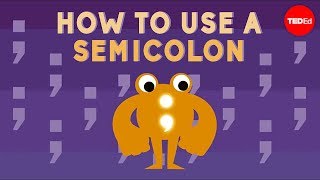(单词翻译:单击)
It may seem like the semicolon is struggling with an identity crisis.
分号看起来好像在为身份危机争斗着。
It looks like a comma crossed with a period.
它看着像逗号和句号的杂交产物。
Maybe that's why we toss these punctuation marks around like grammatical confetti.
也许这就是我们为什么要像语法彩纸一样把这些标点符号一层层剥开。
We're confused about how to use them properly.
我们还困惑着如何恰当得使用分号。
In fact, it's the semicolon's half-half status that makes it useful.
事实上,正是分号的一半一半的状态才使它有用。
It's stronger than a comma, and less final than a period.
它比逗号更斩钉截铁,又不像句号那么不可更改。
It fills the spaces in between, and for that reason, it has some specific and important tasks.
它填在句子之间,由此,它肩负着特殊而重要的任务。
For one, it can clarify ideas in a sentence that's already festooned with commas.
其一,它可以在一个句子里澄清观点,就算这个句子已经用逗号结束了。
'Semicolons: At first, they may seem frightening, then, they become enlightening,
“分号:起初它们可能看起来很唬人,随后它们变得有启发性,
finally, you'll find yourself falling for these delightful punctuation marks.'
最终你会发现自己爱上这些讨人喜欢的标点符号。”
Even though the commas separate different parts of the sentence, it's easy to lose track of what belongs where.
尽管逗号分隔句子的不同部分,它还是很容易把握不好什么成分属于哪里。
But then the semicolon edges in to the rescue.
但是,分号就可以挤进去营救这种情况。
In list-like sentences, it can exert more force than commas do,
在列表式的句子中,分号会比逗号发挥更多的力量,
cutting sentences into compartments and grouping items that belong together.
分号将句子切成间隔,再把同类的项目分成一组。
The semicolon breaks things up, but it also builds connections.
分号把句子分解开,但同时也构建了彼此之间的联系。
Another of its tasks is to link together independent clauses.
它的另一个任务是将独立分句连在一起。
These are sentences that can stand on their own,
那些句子本身都可以独立成句,
but when connected by semicolons, look and sound better because they're related in some way.
但当它们被分号连起来的时候,它们会看起来更顺眼,读起来更朗朗上口,因为它们在某方面是相关的。
'Semicolons were once a great mystery to me. I had no idea where to put them.'
“分号曾经一度对我来说是巨大的谜团。我不知道该把它们放在哪。”

Technically, there's nothing wrong with that.
技术上来讲,这句话没有任何问题。
These two sentences can stand alone.
这两个句子确实可以独立成句。
But imagine they appeared in a long list of other sentences, all of the same length, each separated by periods.
但是设想下它们出现在一连串其他句子之间,它们长度一样,每个句子之间都用句号分开。
Things would get monotonous very fast.
这立马就会显得非常单调。
In that situation, semicolons bring fluidity and variation to writing by connecting related clauses.
在那样的情况下,分号通过连接相关的子句,让写作更流畅多变。
But as beneficial as they are, semicolons don't belong just anywhere.
但就算分号有很多的好处,它并不适用于任何地方。
There are two main rules that govern their use.
有两条主要规则管理着它们。
Firstly, unless they're being used in lists, semicolons should only connect clauses that are related in some way.
首先,除非它们被用在列表里,分号只能连接在某些方面相关的句子里。
You wouldn't use one here, for instance:
你不可以用在这里,举个例子:
'Semicolons were once a great mystery to me; I'd really like a sandwich.'
“分号曾经一度对我来说是巨大的谜团;我真的很想要一个三明治。”
Periods work best here because these are two totally different ideas.
句号最适用于这里,因为这是两个完全不同的想法。
A semicolon's job is to reunite two independent clauses
一个分号的职责就是重新连接两个独立的子句,
that will benefit from one another's company because they refer to the same thing.
这两个子句在对方陪伴的情况下彼此都会获益,因为它们指向的是同一件事。
Secondly, you'll almost never find a semicolon willingly stationed before coordinating conjunctions:
第二,你几乎看不见分号被安置在协调的连词之前:
the words, 'and,' 'but,' 'for,' 'nor,' 'or,' 'so,' and 'yet.'
比如:“和”、“但是”、“因为”、“也不”、“或者”、“所以”和“然而”。
That's a comma's place, in fact.
事实上那是逗号的位置。
But a semicolon can replace a conjunction to shorten a sentence or to give it some variety.
但是分号可以代替连词使句子缩短,或者使句子多变。
Ultimately, this underappreciated punctuation mark can give writing clarity, force, and style,
最终,这个不受欢迎的标点符号可以使写作清晰、有力量、有风格,
all encompassed in one tiny dot and squiggle that's just waiting to be put in the right place.
这些所有的功能浓缩在一个小的点和一个不规则的曲线里,就等着把它安放在那个对的位置了。


